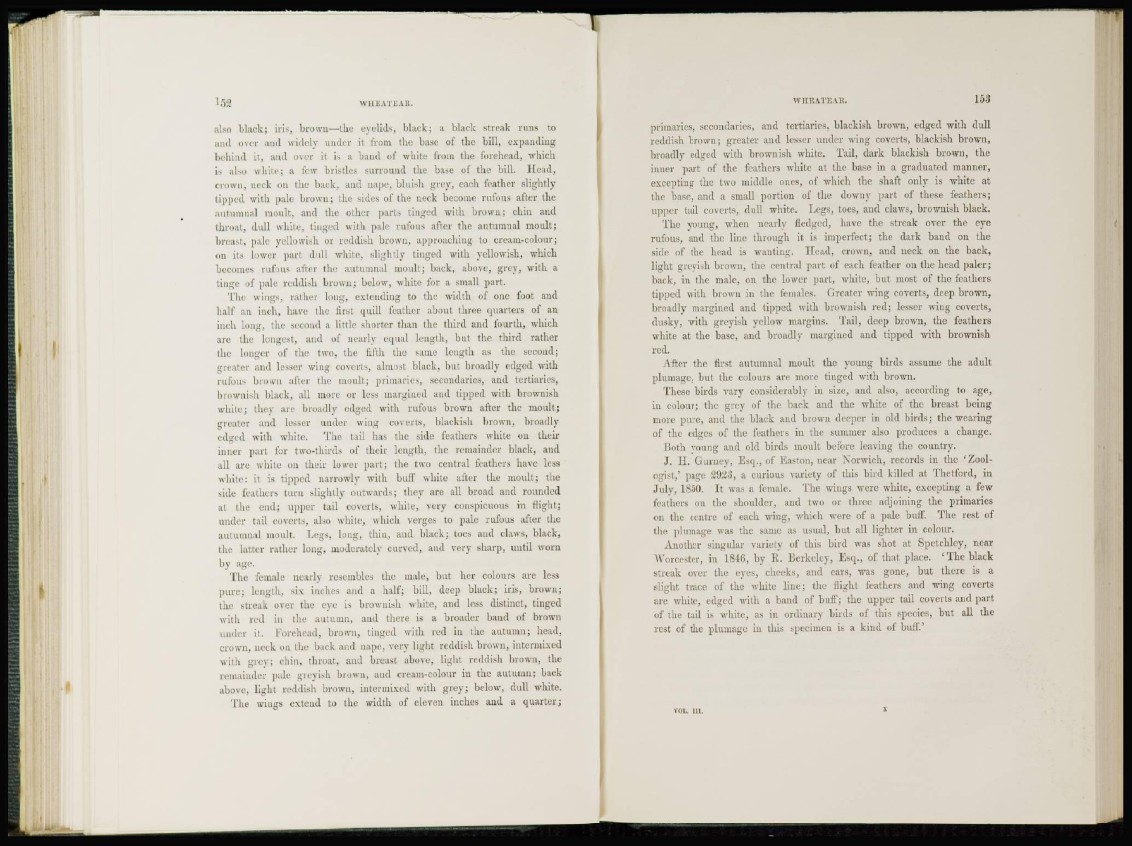
152 WHEATEA R. WHEATEAR. 153
also black; iris, brown—-I be eyelids, black; a black streak runs to
and over and widely under it from the base of the bill, expanding
behind it, and over it is a band of white from the forehead, which
is also white; a few bristles surround the base of the bill. Head,
crown, neck on the back, and nape, bluish grey, each feather slightly
tipped with pale brown; the sides of the neck become rufous after the
autumnal moult, and the oilier parts tinged with brown; chin and
throat, dull while, tinged with pale rufous after the autumnal moult;
breast, pale yellowish or reddish brown, approaching to cream-colour;
on its lower part dull white, slightly tinged with yellowish, which
becomes rufous after the autumnal moult; back, above, grey, with a
tinge of pale reddish brown; below, white for a small part.
The wings, rather long, extending to the width of one foot and
half ! u inch, have the first quill feather about three quarters of an
inch long, the second a little shorter than the third and fourth, which
are the longest, and of nearly equal length, but the third rather
the longer of the two, the fifth the same length as the second;
greater and lesser wing coverts, almost black, but broadly edged with
rufous lu-own after the moult; primaries, secondaries, and tcrtiaries,
brownish black, all more or less margined and tipped with brownish
white; they are broadly edged with rufous brown after the moult;
greater and lesser under wing coverts, blackish brown, broadly
edged with white. The tail has the side feathers white on their
inner part for two-thirds of their length, the remainder black, and
all are white on their lower part; the two central feathers have less
white: it is tipped narrowly with buff white after the moult; the
side feathers turn slightly outwards; they are all broad and rounded
at the end; upper tail coverts, white, very conspicuous in flight;
under tail coverts, also white, which verges to pale rufous after the
autumnal moult. Legs, long, thin, and black; toes and claws, black,
the latter rather long, moderately curved, and very sharp, until worn
by age.
The female nearly resembles the male, but her colours arc less
p u r e ; length, six inches and a half; bill, deep black; iris, brown;
the streak over the eye is brownish white, and less distinct, tinged
with red in the autumn, and there is a broader band of brown
under it. Forehead, brown, tinged with red in the autumn; head,
crown, neck on the back and nape, very light reddish brown, intermixed
with grey; chin, throat, and breast above, light reddish brown, the
remainder pale greyish, brown, and cream-colour in the autumn; back
above, light reddish brown, intermixed with grey; below, dull white.
The wings extend to the width of eleven inches and a quarter;
primaries, secondaries, and tertiaries, blackish brown, edged with dull
reddish brown; greater and lesser under wing coverts, blackish brown,
broadly edged with brownish white. Tail, dark blackish brown, the
inner part of the feathers white at the base in a graduated manner,
excepting the two middle ones, of which the shaft only is white at
the base, and a small portion of the downy part of these feathers;
upper tail coverts, dull white. Legs, toes, and claws, brownish black.
The young, when nearly fledged, have the streak over the eye
rufous, and the line through it is imperfect; the dark band on the
side of the head is wanting. Head, crown, and neck on the back,
light greyish brown, the central part of each feather on the head paler;
back, in the male, on the lower part, white, but most of the feathers
tipped with browu in the females. Greater wing coverts, deep brown,
broadly margined and tipped with brownish red; lesser wing coverts,
dusky, with greyish yellow margins. Tail, deep brown, the feathers
white at the base, and broadlv margined and tipped with brownish
red.
A Iter the first autumnal moult the young birds assume the adult
plumage, but the colours are more tinged with brown.
These birds vary considerably in size, and also, according to age,
in colour; the grey of the back and the white of the breast being
more pure, and the black and brown deeper in old birds; the wearing
of the edges of the feathers in the summer also produces a change.
Both young and old birds moult before leaving the country.
J. H. Gurncy, Esq., of Easton, near Norwich, records in the 'Zoologist/
page £92o, a curious variety of this bird killed at Thctford, in
July, 1850. It was a female. The wings were white, excepting a few
feathers on the shoulder, and two or three adjoining the primaries
on the centre of each wing, which were of a pale buff. The rest of
the plumage was the same as usual, but all lighter in colour.
Another singular variety of this bird was shot at Spetchley, near
Worcester, in 184b', by R. Berkeley, Esq., of that place. 'The black
streak over the eyes, cheeks, and ears, was gone, but there is a
slight trace of the white line; the flight feathers and wing coverts
are wdiite, edged with a band of buff; the upper tail coverts and part
of the tail is white, as in ordinary birds of this species, but aU the
rest of the plumage in this specimen is a kind of buff.'